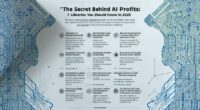Artificial Intelligence (AI) has become the ultimate buzzword in tech and investing circles. Every headline screams about NVIDIA, Microsoft, and OpenAI, and how they’re driving the AI revolution. But here’s the truth most investors overlook — the real money in AI isn’t just in the companies building large language models or GPUs. It’s in the hidden players quietly powering, supplying, and scaling the entire ecosystem.
Let’s pull back the curtain on where the smart money is really going in the AI megatrend — and why the next trillion-dollar opportunities may not come from the obvious tech giants.
The AI Gold Rush — and the Picks-and-Shovels Strategy
When gold was discovered in California in 1849, the people who made the most money weren’t the miners — they were the ones selling picks, shovels, and tools.
In today’s AI boom, the same logic applies. Everyone is chasing “AI gold,” but the biggest profits are going to infrastructure, data, and energy companies that enable AI to exist.
From semiconductor suppliers to data center operators, the value chain supporting AI workloads is massive — and growing fast.
The Infrastructure Behind AI — Data, Power, and Cooling
AI models like GPT-4.5 or Gemini don’t run on thin air. They need massive computing infrastructure, reliable power, and efficient cooling systems. This is where the real growth is happening.
Data centers are the new digital oil fields. Companies like Equinix (EQIX) and Digital Realty (DLR) are quietly becoming the backbone of the AI age. Every chatbot, image generator, and recommendation algorithm needs a data center to process and store information.
These companies provide the physical space, networking, and energy efficiency needed to handle huge AI workloads. As demand for training and inference grows, their revenues could surge for years.
Energy is also the hidden AI enabler. A single AI query can consume 10x more electricity than a regular Google search. That’s why energy producers are becoming crucial AI partners.
Firms investing in renewable energy like NextEra Energy or AI-optimized power grids like Schneider Electric are quietly winning big. AI companies need clean, scalable, and affordable power, making the energy sector one of the biggest beneficiaries of the AI megatrend.
The AI Supply Chain — Materials, Chips, and Hardware
While NVIDIA dominates headlines, the AI chip ecosystem goes far deeper than GPUs. The companies that supply, manufacture, or package these chips are also cashing in.
Semiconductor equipment makers like ASML, Applied Materials, and Lam Research are the lifeblood of AI hardware production. Without their photolithography and wafer-processing machines, NVIDIA and AMD couldn’t make their chips.
Investors often overlook these suppliers — but they’re the ones profiting every time a new data center expands or an AI lab orders more GPUs.
Chip substrate and packaging firms like ASE Technology and Amkor are also crucial. As AI chips get more advanced, demand for high-performance packaging grows exponentially. These players may not be household names, but they’re essential to the AI ecosystem — and often enjoy high profit margins.
Software Winners Beyond Big Tech
AI isn’t just changing hardware; it’s rewriting the rules for software too. But once again, it’s not always the biggest names leading the change.
Enterprise platforms like ServiceNow, Salesforce, and HubSpot are embedding AI deeply into their existing tools. They use machine learning to automate workflows, predict customer behavior, and personalize user experiences — all of which improve efficiency and drive new subscriptions.
These companies don’t need to invent new AI — they just need to deploy it better than anyone else.
Cybersecurity firms like CrowdStrike and Palo Alto Networks are also using AI defensively. With deepfakes, phishing, and automated attacks on the rise, AI-powered security is becoming mission-critical.
These companies use AI models to predict and prevent cyber threats before they happen — and in a world obsessed with data, that’s an invaluable service.
The AI Boom in Real-World Industries
Beyond tech and software, AI is quietly transforming industries like healthcare, logistics, and agriculture.
In healthcare and biotech, AI is revolutionizing drug discovery, diagnostics, and personalized medicine. Companies like Illumina (genomic data) and Moderna (AI-guided vaccine development) are integrating AI to make breakthroughs faster and cheaper.
In logistics and manufacturing, AI-driven automation is helping factories reduce waste and optimize production. Firms like Siemens, ABB, and Rockwell Automation are embedding AI into their industrial systems — boosting productivity and margins.
AI is also entering agriculture, optimizing crop yields and predicting climate impact. Companies in precision agriculture, like Deere & Co. (John Deere), are using AI to transform how we grow food sustainably.
Why the Smart Money Avoids the Hype
It’s tempting to pour money into the obvious AI names — NVIDIA, OpenAI, or Google. But the smartest investors know that AI’s biggest winners aren’t always the ones in the spotlight.
Instead, they follow the data, power, and supply chain. They invest in companies that benefit from AI demand indirectly — without the risk of overvaluation or technological obsolescence.
In other words, the smart money goes where AI growth meets real-world necessity.
The Next Decade of AI Investing
Over the next 10 years, AI will expand beyond chatbots and image generators into every corner of the economy. That means countless secondary industries — energy, manufacturing, logistics, and healthcare — will quietly ride the AI wave.
By identifying these under-the-radar players early, investors can position themselves ahead of the crowd.
Because while everyone is chasing the next ChatGPT, the true fortunes will be built by those who understand the hidden side of AI.
Final Thoughts
The AI revolution isn’t a single story — it’s an ecosystem. And while tech giants dominate headlines, the real winners are the companies supplying the power, infrastructure, and intelligence that make AI possible.
From data centers to clean energy and industrial automation, the hidden side of AI holds enormous potential. The investors who recognize that — and act early—could find themselves on the right side of the next trillion-dollar wave.









